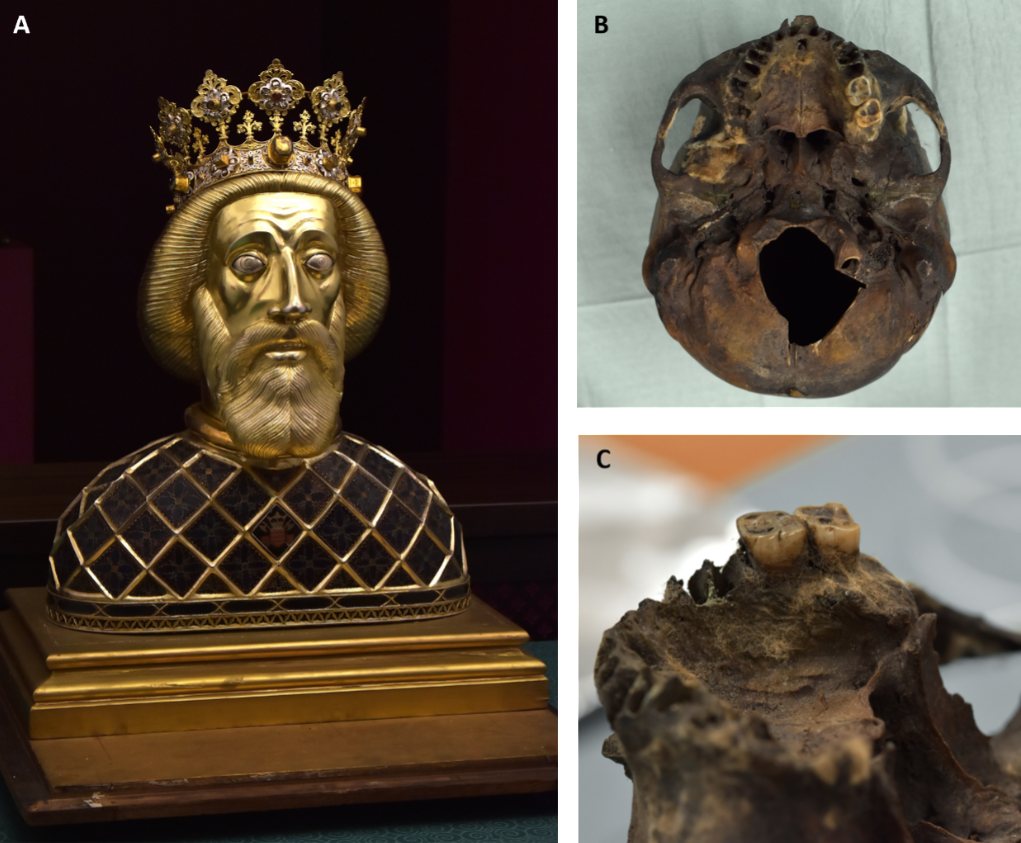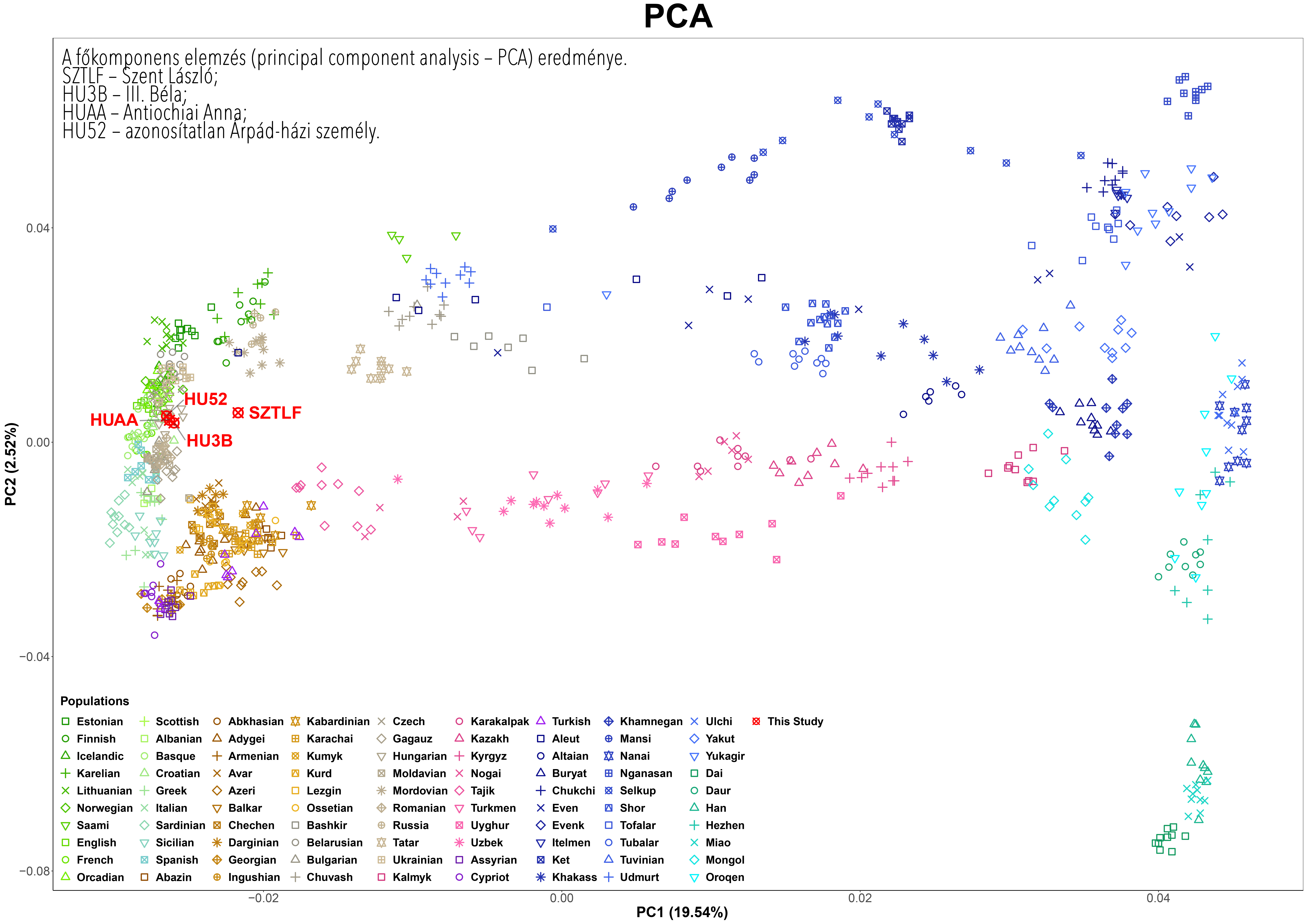Extraordinary news: researchers of the Institute of Hungarian Research and the University of Szeged have verified the world's first holy relic: the St. László Herma in Győr contains the skull of St. László
Researchers from the Research Centre for Archaeogenetics of the Institute of Hungarian Research and the Department of Genetics of the University of Szeged have confirmed the authenticity of the skull relic of Saint László by means of archaeogenetic analyses.
Their results are published in the international Journal of Genetics and Genomics, available here: DOI: https://doi.org/10.1016/j.jgg.2022.06.008

In the publication, the complete genome sequence of St. László was compared with the genome data of three other individuals, namely King Béla III, Queen Anne of Antioch and a previously unidentified male of the Árpád dynasty, which are also published in this article. The genome of the first monarch, Béla III, identified by the research team led by Prof. Dr Miklós Kásler, has been the source and origin of archaeogenetic research on the Árpád dynasty.
In addition to proving the authenticity of the relic of our holy king, the significance of the results of the publication is further enhanced by the fact that, using the genome of Saint László as a reference point, the identity of the royal remains found so far has also been established, and new important information about the origins of our first dynasty has been provided.

The extract of the family tree of the Árpád dynasty. It exclusively contains the male members of the Turul dynasty (Árpád dynasty) with Anna of Antioch. Green - genetically identified remains; yellow - presumed identity of unidentified remains
Natural scientific examinations (anthropological, morphological analysis, CT scan, dental examination, etc.) of the relic in the St. László Herma, which is in the custody of the Diocese of Győr, were first carried out in 2017 (SZENT KIRÁLY, LOVAGKIRÁLY - A SZENT LÁSZLÓ-HERMA ÉS A KOPONYAEREKLYE VIZSGÁLATAI (Holy king, Knight-king - Analyses of the St. László-herma and the skull treasures), Eds. Lilla Alida Kristóf, Zoltán Lukácsi and Lajos Patonay, 2017). However, genetic analyses at the time were unsuccessful, and the skull could not be identified as authentic.
In 2021, the Institute of Hungarian Research was requested to attempt a successful DNA analysis, with the support of the Diocese of Győr. The research team extracted the DNA from tooth roots using a special non-destructive method on 4 June 2021. Contrary to previous information, the genetic heritage of the holy king was preserved in such high quality and high purity that sequencing and analysis could be performed with a high resolution comparable to the analysis of the genome of a living human being today.

The analysis of the Y chromosome confirmed beyond any doubt that the individual in question is a male member of the Árpád dynasty: his sequence is identical to that of Béla III. This also refuted the idea that a foreign skull had been placed in the herma, which had been damaged by fire in the 15th century, and that the skull had been reconstructed, thus its authenticity was established.
The researchers then compared the complete genomes of the previously discovered Árpád dynasty remains to establish the kinship relations between the individuals. The analysis revealed a fifth-degree relation between St. László and Béla III, exactly corresponding to their family ties. This result also confirmed that the royal remains discovered in Székesfehérvár in the 19th century did indeed belong to King Béla III, and not to Kálmán the Learned, who was the nephew of the knight-king, i.e., a second-degree relative. In 2019, Olasz and alia announced that they identified another man from the Árpád dynasty from among the remains excavated in Székesfehérvár and later placed in the Matthias Church, but they were unable to establish his identity. In their 2021 publication, Nagy and alia confirmed that the remains belonged to the Árpád dynasty by determining the sequence of the entire Y chromosome.
OUR PRESENT INVESTIGATIONS HAVE REVEALED THAT THE PERSON IN QUESTION IS A SECOND-DEGREE RELATIVE OF BOTH BÉLA III AND HIS WIFE, ANNA OF ANTIOCH, AND THEREFORE CAN ONLY BE A GRANDCHILD OF THE ROYAL COUPLE. Based on the historical data, the burial places of the royal family members and the ages of death, the individual in question was most likely ENDRE, ROYAL PRINCE OF HUNGARY, DUKE OF HALICS, SON OF ANDRÁS II.
Genome analyses clearly indicated that the genome of Saint László contains a much higher level of Eastern, Asian heritage than that of the other royal family members, in whom this had been diluted to undetectable levels during dynastic marriages. Thus, for example, the genome of Béla III and his grandson is most similar to that of present-day Hungarians and Croats. The highest resolution (so-called qpAdm) analyses have shown that the eastern component of the genome of Saint László matches the component recently identified by the research team as specific to the founding elite (https://doi.org/10.1016/j.cub.2022.04.093 ), which accounts for about 15% of the genome of the knight-king. This result confirms the common ancestry of the Turul clan and the Hungarian founding elite and refutes the possibility that, contrary to some theories, the Árpád dynasty could have been a ruling family of foreign origin, placed at the head of the Hungarians by an external power. Our data are in line with the information in the Illustrated Chronicle, according to which the founding Hungarians chose seven leaders from among themselves, and the richest and most powerful leader was Árpád, son of Álmos, from the Megyer tribe.